
Today marks the 80th anniversary of the attack on Pearl Harbor, Hawaii, which launched the United States into World War II.
While Pearl Harbor was not the only place to be hit- other targets of the day included Wake Island, Midway, Guam, the Philippines, and Shanghai*- the losses in Hawaii particularly startled and frightened the American people. Hawaii seemed too close to the mainland, and the far-off war suddenly seemed terribly real.
My family and I had the solemn privilege of visiting several of the memorials at Pearl Harbor in 2019. Today, it seemed fitting to revisit the sites with you.
The USS Arizona Memorial
The attacks by Japanese planes on December 7, 1941 shocked, unified, and galvanized the American people, finally and fully committing the United States to the Allied cause.
The most famous site of the attack, “battleship row” of Pearl Harbor, has been set aside for memorials to those who lost their lives.
Our first Pearl Harbor stop was the WWII Valor in the Pacific National Monument, the home of the USS Arizona memorial.
On the morning of December 7, 1941 the battleship Arizona floated peacefully in Pearl Harbor, tied to its mooring quay. At the time, Oahu hosted more than half of the U.S. Pacific fleet- around 150 vessels.
By 10 am, twenty-one of those ships were sunk or damaged. More than 2,400 people had been killed.
1,177 of these casualties were from the Arizona, which exploded when a bomb pierced her deck and hit the powder magazine.
Designated a National Historic Landmark in 1964, Pearl Harbor still holds the remains of the Arizona and entombs the sailors who went down with her.
The USS Arizona memorial is suspended in the harbor above (but not touching) the remains of the ship.

The Navy runs boats to take visitors out to view the memorial up close. The tickets are free, but they are limited in number and first-come-first-served.
We had about an hour until it was our turn to go out, which gave us an excellent chance to explore.
Past the ticketing area, a palm-lined path led us first to the massive anchor of the Arizona.

“The Lone Sailor” stands facing the anchor and the water.
“The Lone Sailor represents the men and women who have served, are serving, or will serve in the Navy.”
It’s quite a job, but judging by his confident expression, it seems that he’s up to the task.
Off to the right of the anchor is the USS Bowfin Submarine Museum and Park.
Near the entrance to the museum, an outdoor memorial commemorates the 52 U.S. submarines and their 3,500 officers and crewmen lost during the Second World War.
The Bowfin and submarine museum are available to tour for a fee.


Heading back towards the area where we would embark to the Arizona memorial, we passed signs, displays, and two small (but excellent) museums detailing the events of December 7th.

While the park was beautiful, we noted that some of the signs were in disrepair, which is a pity. Perhaps this is just a result of keeping the entry free. We were also informed that we wouldn’t be able to actually disembark and walk through the Arizona memorial, as the dock was broken.
On a more positive note, we did hear that when the memorial was going to be closed during the recent government shut-down, local businesses pulled together to keep it open.

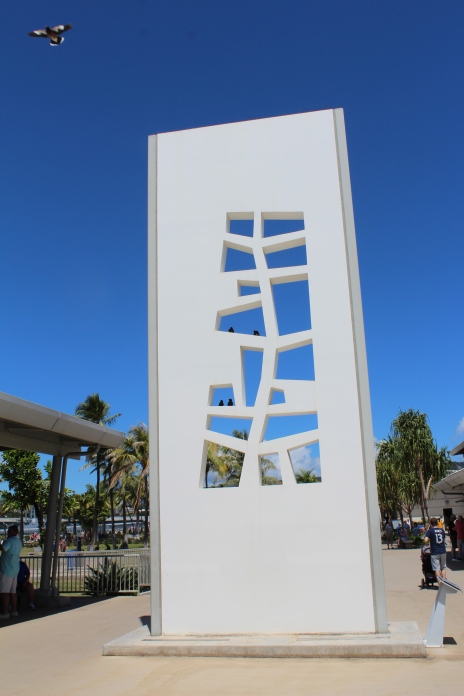
Before sailing over to the memorial, we and the other visitors in our time slot viewed a 20 minute film detailing the history of the Arizona and Pearl Harbor.
Viewing the film’s historical footage while sitting next to the place where it happened is one of those experiences that doesn’t really translate into writing. I’ll simply say that the film was both informative and moving. At the end, my eldest turned to me with a somber face and said, “Now I understand why we came here.”
The lower theater exit opened, and we boarded the ship to go out and pay our respects.
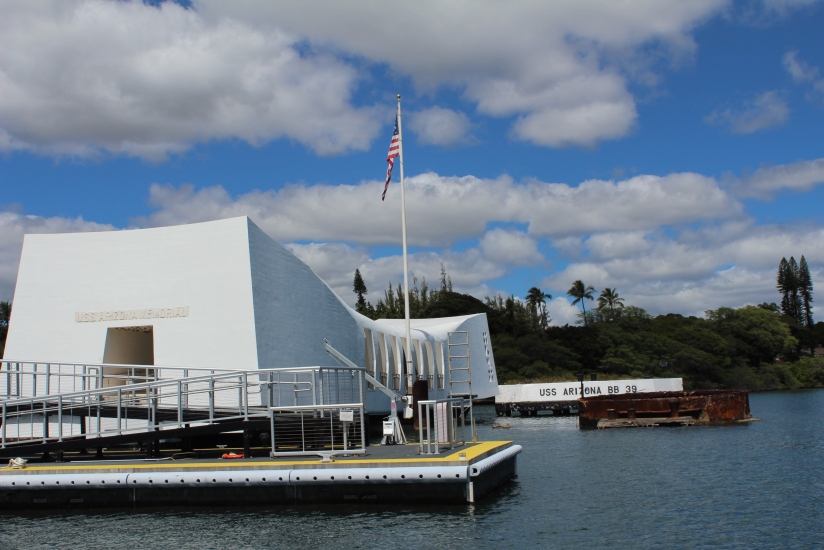

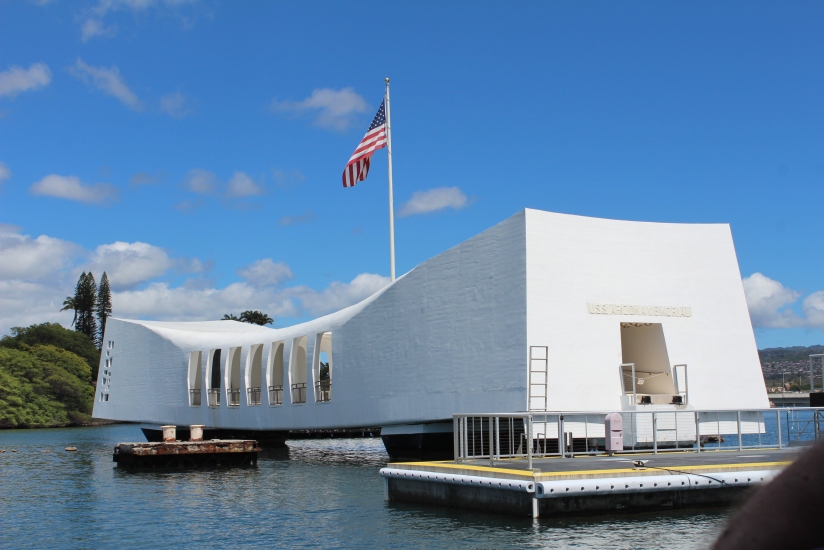
The design of the memorial includes a great deal of symbolism.
The designer, Austrian-born Alfred Pries, (who fled his homeland when Hitler invaded and settled with his wife in Honolulu) wanted the raised end at the beginning of the memorial to denote America’s pride before the war.
The sinking middle is meant to symbolize the country’s shock and sorrow after the Pearl Harbor attack. The seven windows that you can see in this section stand for December 7th. All together there are 21 windows in the monument, representing a 21 gun salute.
The floor of this middle portion or “Assembly Hall” of the memorial has a section cut away so that, when the dock is useable, visitors can look down and view the wreck.
The raised far end is to show how the United States regained its strength after the war. In this final section, the “Shrine,” all of the names of the victims of the USS Arizona are carved on the walls.
Oil still leaks from the wreck of the Arizona, drifting to the surface in black tears.
Survivors of the USS Arizona have the option, upon their death, to have their remains returned to the ship to rest with those who never left it.
The USS Utah Memorial
While the Arizona memorial is open to the general public, memorials to the Utah and Oklahoma are on Ford Island, which is still used by the military as part of Joint Base Pearl Harbor-Hickam. To see these memorials, one needs special permission OR (as we were fortunate enough to have on our visit) military friends stationed in the area who will act as an escort.
Unlike the busy Arizona memorial, the resting place of the Utah is rather lonely and unassuming. Our party had the little parking area to ourselves.
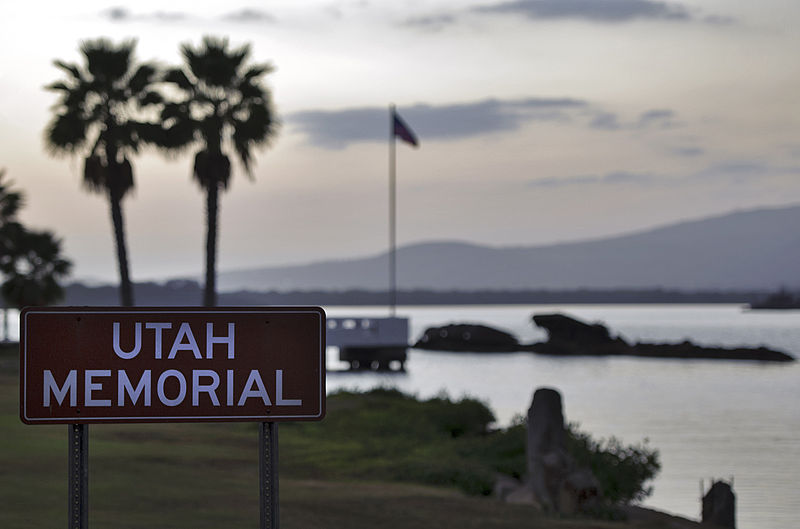
By 1941 the Utah was already past her prime. Launched in 1909, she served in WWI. She was demilitarized in 1931 and repurposed as a target ship for training.

The Utah was on the opposite side of Ford Island from the Arizona and other prime targets for Japanese planes. Just why she ended up having six torpedoes fired on her is an open question. Perhaps it was a case of mistaken identity.
Whatever the reason, sixty-four of the training ship’s officers and crew were lost.
It might have been more if Lt. Commander Solomon Isquith hadn’t organized a rescue crew when he and others who’d escaped heard the frantic knocking on the hull of survivors trapped inside.
Braving the Japanese planes still strafing the harbor, they returned to their sunken ship to cut the hull open and save those they could.
The Utah was never salvaged, and still rests in Pearl Harbor, entombing those who went down with her.
The original Utah memorial was a plaque on the wrecked remains.
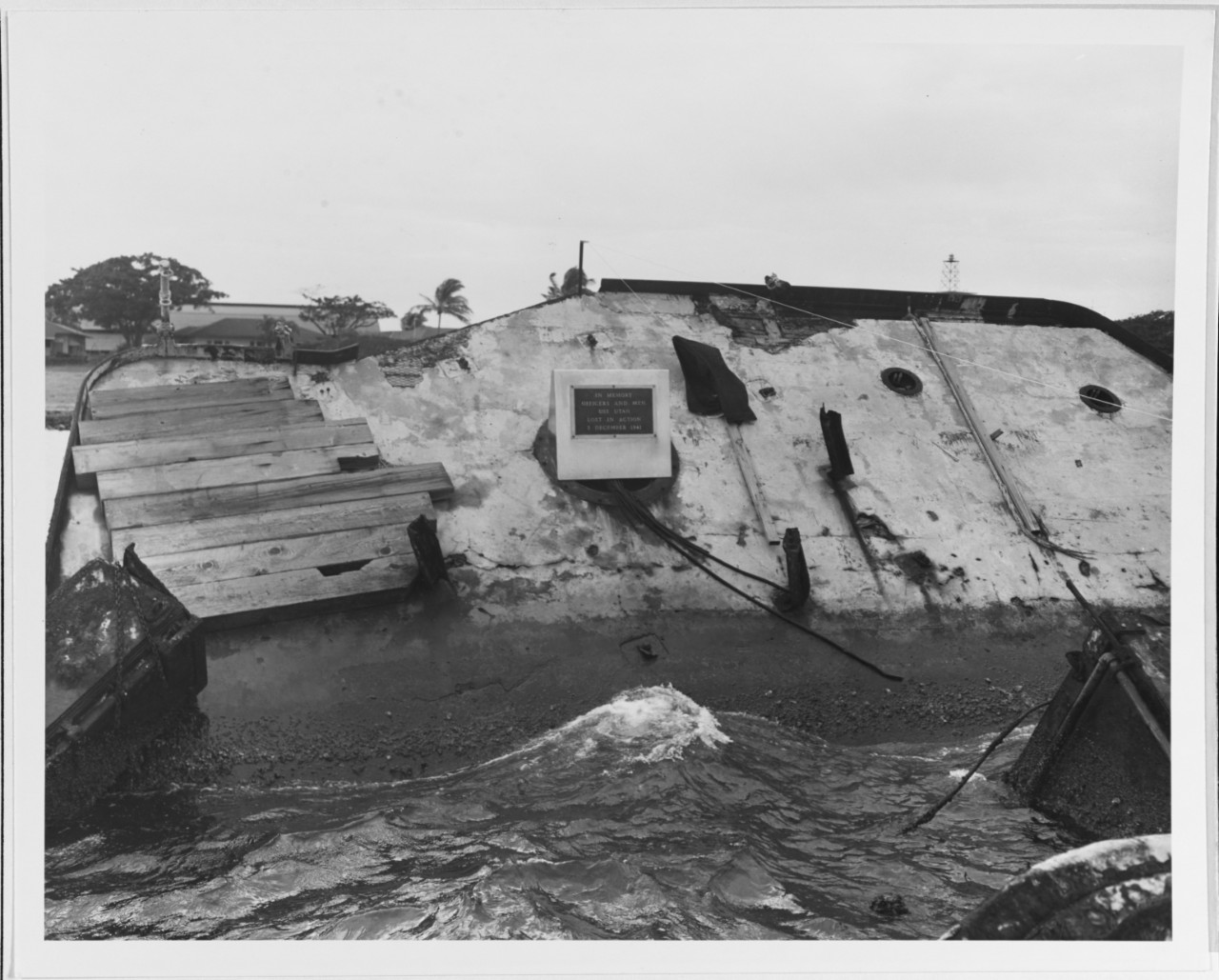
A new memorial was built in 1972. The simple white structure offers a close view of the ship’s remains. Below the raised American flag, a plaque commemorates those who were lost.
Like the Arizona survivors, survivors of the Utah have the option of having their ashes returned to the ship upon their passing, to join those who never left.




The USS Oklahoma Memorial
Unlike the Utah, the USS Oklahoma was still a fully active battleship in 1941. On the morning of December 7, she was tied up just down Battleship Row from the Arizona.
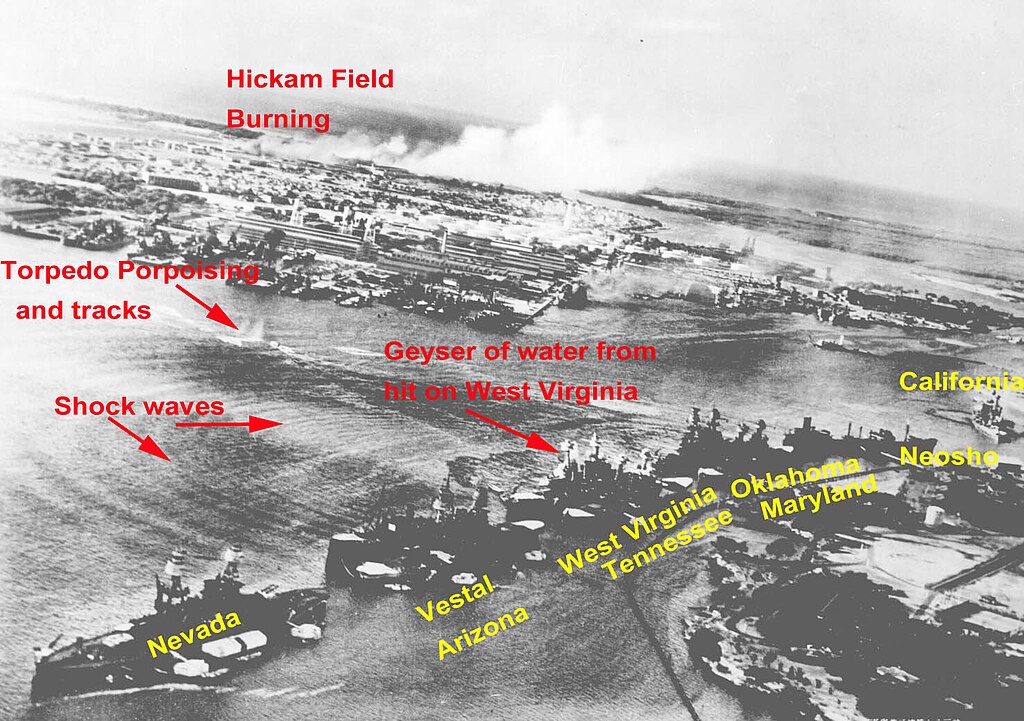
Struck by at least 9 torpedos, it took only 13 minutes for the Oklahoma to capsize. Sailors tried to evacuate over the starboard side, but as she rolled over hundreds were trapped inside.

There are many stories of bravery from the Oklahoma’s tradgedy- honors given to her crew include 2 posthumous Medals of Honor and one Navy Cross.
One award particularly caught my eye, as it was given just two years ago.

Father Schmitt had finished morning Mass and was reportedly hearing confession on board the USS Oklahoma when the first torpedos hit. He assisted twelve sailors to escape through a porthole.
When he attempted his own escape, he became stuck.
Hearing other sailors in the compartment behind him, he insisted on being pushed back into the doomed vessel, so that others could escape.
His remains were identified recently, and his family was awarded his posthumous Silver star in 2017.
Those who escaped the Oklahoma worked frantically for days to cut through the ship’s hull to rescue trapped survivors.
In spite of their best efforts, they were only able to rescue 32. All told, the Oklahoma suffered 429 losses- the second highest loss of life after the Arizona.

429 white marble pillars stand at the Oklahoma‘s memorial, one for each life lost.

A black stone marker at the memorial sums up the meaning of the place best. A portion of it reads:
Manning the Rails
As Navy vessels pass through Pearl Harbor, sailors and Marines stand at attention along the ships railing and superstructure. The crew’s dress uniforms contrast sharply against the grey vessels.
***
In full dress uniform, the ship’s crew stands at attention in a display of respect and honor- coming home for a final time by manning the rails.

The USS Oklahoma no longer rests in Pearl Harbor.
The Navy attempted to salvage her, patching and refloating her. However, the damage was too great. The Oklahoma was decommissioned in 1944. According to another plaque at the memorial:
Sold for scrap, she was en route to the west coast when she mercifully broke her tow and sank on 17 May, 1947.
Anniversary Events
While many locations are holding ceremonies in commemoration of this day, The National Park Service site lists several events taking place at Pearl Harbor itself, and videos of events from the past. Here is a link to their page.
*The location of the International Date Line means that history records some of these events as taking place on December 8th even though they were within hours of each other.


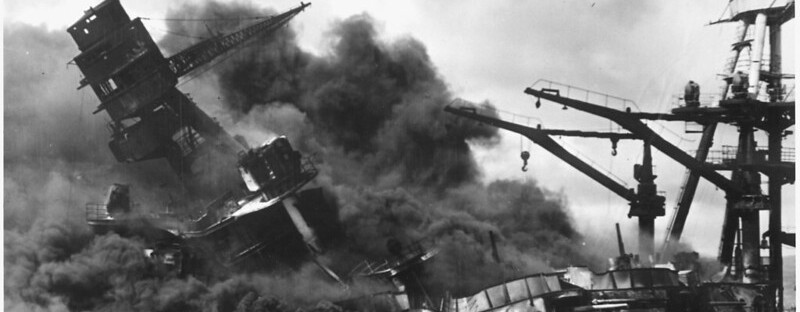


Excellent! I like the way you mixed all photos with modern.
LikeLiked by 1 person
Thank you so much.
LikeLike
Thank you for sharing the Father Schmitt story. It is so sad to think of all that died on that day.
LikeLiked by 1 person
It is a sad story, but also one of those moments when courage and faith shine out in terrible times- those are the kinds of stories that keep me reading history. Thank you for stopping by.
LikeLiked by 1 person
Thank you for remembering, lest we forget…
LikeLiked by 1 person
Thank you for stopping by and remembering with me.
LikeLiked by 1 person
That would be a sobering visit. Pleased your son understood the importance of it.
LikeLiked by 1 person
It was, but it was a great opportunity for the three of them to “see” history. I was so glad that we were able to do it.
LikeLiked by 1 person
I was there once, many years ago. I remember standing on the Arizona Memorial.
LikeLiked by 2 people
It’s a very striking place, isn’t it? I wish we could have gone into the memorial itself, but maybe another time…
LikeLiked by 1 person
Yes.
LikeLike
LikeLiked by 1 person
Reblogged this on John's Notes and commented:
Anne has done a great job of assembling a remembrance of what happened 80 years ago today. The event that made the final push turning the US from an isolationist nation to the powerhouse of WWII. The Day that will live in Infamy!
LikeLiked by 1 person
Thank you so much, John.
LikeLike
A very well presented look at the site and memorials. The place truly is amazing, I remember feeling a lump in my throat the entire time we were there. And I think we figured last time that my wife and I were there within a few months of when you were!?
But being there is a special memory I’ll carry for the rest of my life.
LikeLiked by 1 person
It really was incredible, and very moving- I am so so glad we were able to visit.
I think you’re right about the timing, too. March or April (whenever school had break that year) 2019 for us I think- does that sound right?
LikeLiked by 1 person
Yeah, our anniversary is April 26 and we did a vow renewal on our anniversary the day after we went to Pearl Harbor. So its sort of well anchored in my mind!
LikeLiked by 1 person
Aw, lovely.
LikeLike
Thanks so much for this coverage, Anne. We were going to go there this Xmas but decided to stay home because of Covid. –Curt
LikeLiked by 1 person
Oh, I hope you get to reschedule. It wouldn’t be my choice of time to travel either, though one writer I know made it over for the 80th anniversary ceremonies, and it looked like it was really something. I’m glad I could at least share some pictures! Take care,
-Anne
LikeLike
Thanks, Anne. We will get there. I’ve been to Hawaii many times but have usually tended to avoid Honolulu and focus on the other islands. Pearl Harbor would make the big city worthwhile. –Curt
LikeLiked by 1 person
Honolulu was sooo busy- I loved the visit and seeing the history, but would love to check out the other islands. Someday….
LikeLike
Peggy and I had been already to go for a month, Anne, visiting some our our other favorites first. 🙂
LikeLiked by 1 person